Apollo 13 astronaut Fred Haise describes the dramatic events of the Apollo 13 mission
Astronaut Fred Haise recounts the incredible events of the Apollo 13 mission.
On April 11, 1970, Apollo 13 blasted off into the Florida skies from Launch Pad 39A at Kennedy Space Center atop a massive Saturn V rocket.
The mission, which was crewed by Jim Lovell, Jack Swigert and Fred Haise, marked NASA’s third lunar landing attempt.
Haise was set to become just the sixth person to walk on the lunar surface, right after Apollo 13 Mission Commander Jim Lovell, who would become the fifth.
APOLLO 13 ASTRONAUT FRED HAISE RECOUNTS ILL-FATED MISSION: 'WE NEVER GOT TO THE EDGE OF THE CLIFF'
But 56 hours later, when Apollo 13 was about 200,000 miles from Earth, an oxygen tank in the spacecraft’s Service Module exploded. The mission’s objective quickly shifted from exploration to survival.

The Apollo 13 crewmembers step aboard the USS Iwo Jima, prime recovery ship for the mission, following splashdown and recovery operations in the South Pacific Ocean. Exiting the helicopter which made the pick-up some four miles from the Iwo Jima are (from left) astronauts Fred Haise, lunar module pilot; Jim Lovell., commander; and Jack Swigert, command module pilot. (NASA)
“After the explosion, when I drifted back up into the mothership, the Command Module, I had been in the Lunar Module doing a TV show. Actually, I had just finished it and I looked at the panel and realized that we had lost oxygen tank 2,” Haise told Fox News during a 2019 interview. “I was frankly, immediately sick to my stomach with disappointment, I knew we had lost the landing mission.”
“[I] did not think it was life-threatening … we had a second tank, it looked to be intact,” the Lunar Module pilot added.
STUNNING NASA VIDEO RECREATES APOLLO 13'S TRIP AROUND THE MOON
However, oxygen tank 1 was damaged.
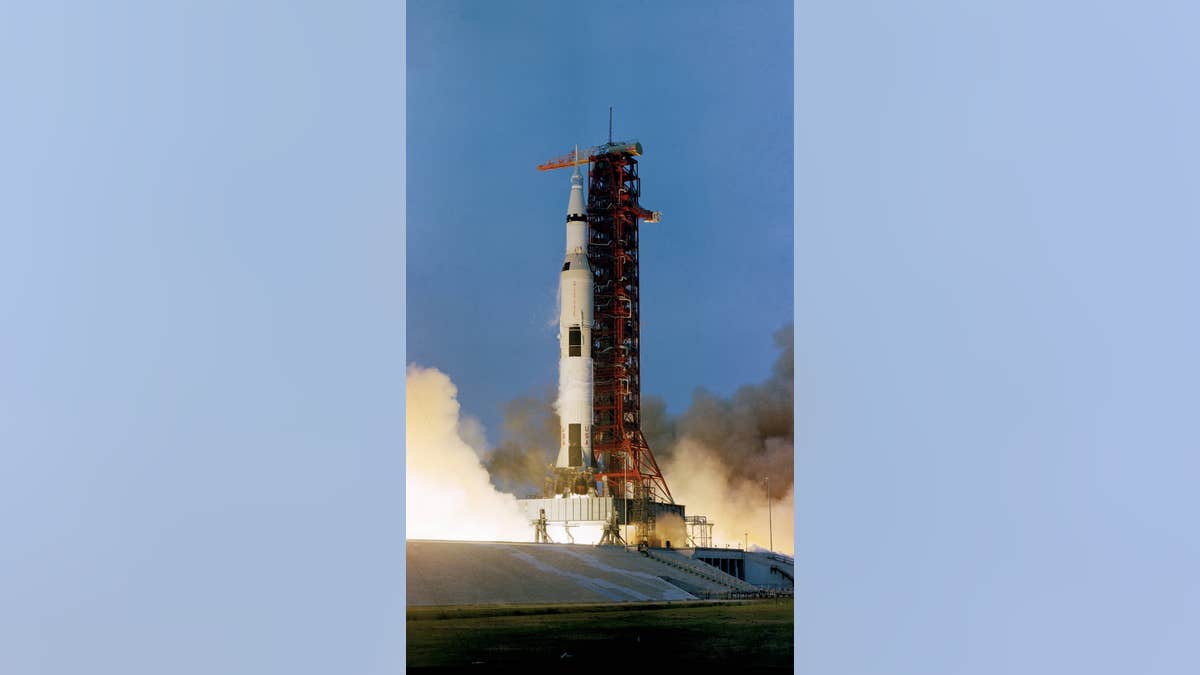
The Apollo 13 launch. (NASA)
“It took some time, actually over probably 20 minutes or more, for the realization became clear that there was a leak, a slow leak, but nevertheless a leak in that tank too,” Haise explained. “Only then did we have the thought of it being life-threatening. We got very busy with the people in Mission Control, trying different isolations and switches to try and isolate the leak and that went on for almost up to an hour – at about that time we came to realize that we had run out of ideas, they and ourselves.”
At that point, Haise and Lovell left Swigert in the Command Module and went to power up the Lunar Module, which they would use as a “lifeboat” to help them get home.
Working with Mission Control, the astronauts overcame numerous challenges. With carbon dioxide in the Lunar Module reaching a dangerous level, the crew had to adapt lithium hydroxide canisters designed for the Command Module to work in the Lunar Module. A swarm of debris from the explosion also made navigation difficult.
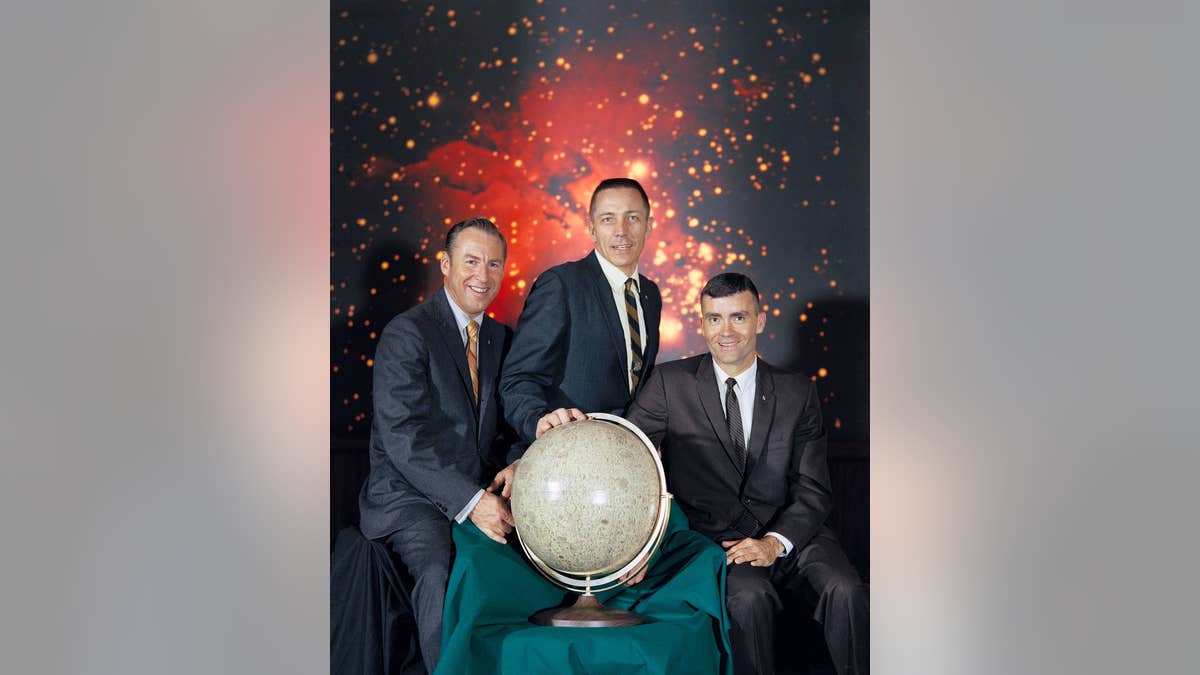
The Apollo 13 crew portrait - from left to right are Mission Commander Jim Lovell, Command Module pilot Jack Swigert and Lunar Module Pilot Fred Haise (NASA)
Suffering from a lack of sleep, food and water within the cold spacecraft, Haise, Lovell and Swigert experienced extreme physical discomfort as they guided Apollo 13 back to Earth.
Nonetheless, Haise told Fox News that he was always confident that the mission would make it home. “There was never a point where we had not got to where we needed - to have something else figured out already, and it wasn’t ready,” he explained. “We never got to the edge of the cliff.”
THE BAG USED BY BUZZ ALDRIN TO CARRY RELIGIOUS ITEMS TO THE MOON SURFACES
With the world anxiously watching, Apollo 13 re-entered Earth’s atmosphere and splashed down in the Pacific Ocean on April 17. The mission became known as a “successful failure.”
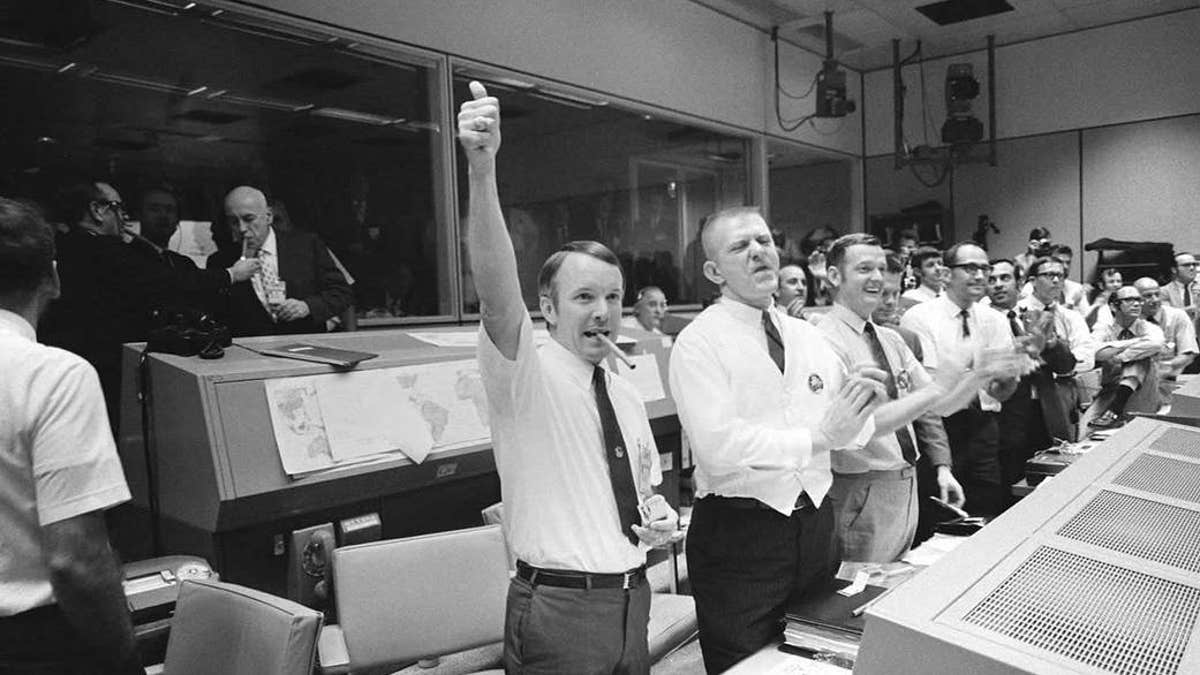
Mission Control celebrates the Apollo 13 splashdown. (NASA)
“Our goal 50 years ago was to save our valiant crew after sending them around the Moon and return them safely to Earth,” said NASA Administrator Jim Bridenstine, in a statement this week.
Apollo 13 was a triumph of innovation and improvisation. On its website, NASA notes that the removal of carbon dioxide from the Lunar Module was a major concern as the stricken spacecraft made its way back to Earth. “There were enough lithium hydroxide canisters, which remove carbon dioxide from the spacecraft, but the square canisters from the command module were not compatible with the round openings in the lunar module environmental system,” it explains.
APOLLO 11: HOW 'DUMB LUCK' SAVED ICONIC MOON PHOTOS FROM BEING DESTROYED
There were four cartridges from the lunar module and four from crew backpacks. However, the lunar module was required to support two men for two days but now had to support three men for about four days. “After a day and a half in the LM, a warning light showed that the carbon dioxide had built up to a dangerous level,” NASA explains on its website. “Mission control devised a way to attach the CM canisters to the LM system by using plastic bags, cardboard and to tape all materials carried on board.”
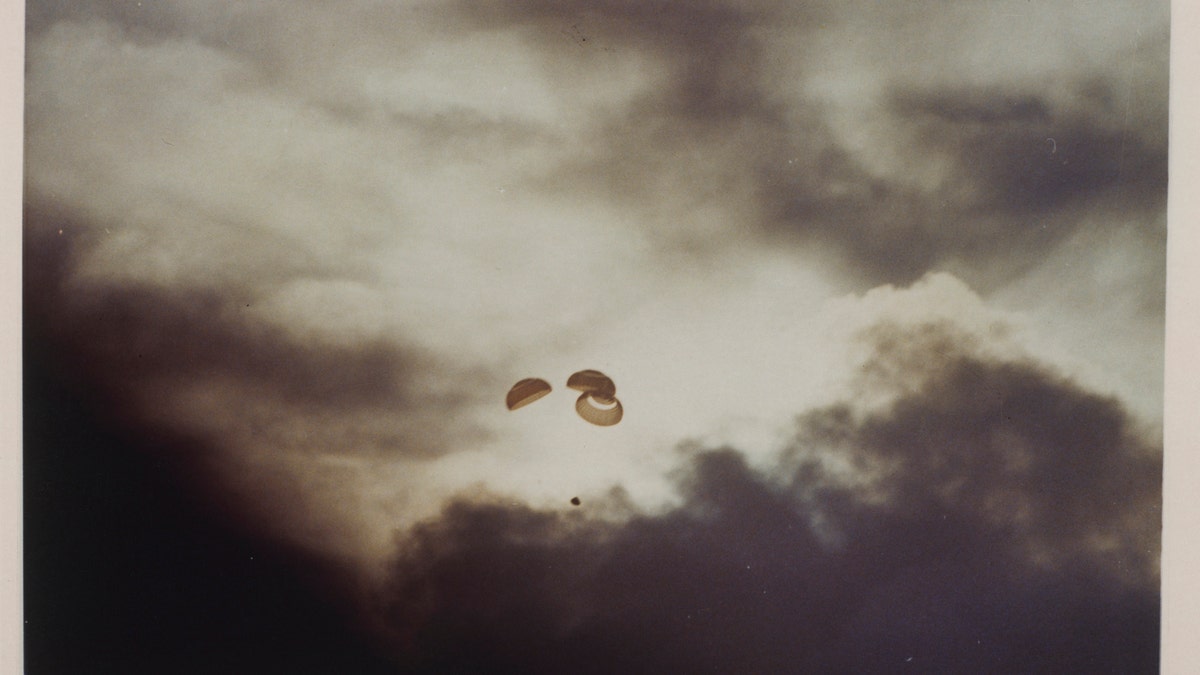
The Apollo 13 spacecraft parachutes to Earth, just before splashdown in the South Pacific Ocean after its aborted lunar landing mission, 17th April 1970. (Photo by Space Frontiers/Getty Images)
The dramatic events of Apollo 13 are depicted in the hit Hollywood movie of the same name, where Haise is portrayed by the late actor, Bill Paxton. Lovell was portrayed by Tom Hanks and Swigert by Kevin Bacon.
The crew of Apollo 13 became part of an exclusive group of astronauts that has seen the far side of the moon. The Apollo 8 mission in 1968 was the first to see the far or “dark side” of Earth’s natural satellite.
APOLLO 8 ASTRONAUTS RECOUNT NASA'S EPIC FIRST MISSION TO THE MOON
Amid the coronavirus pandemic, NASA is not holding any in-person events to commemorate the Apollo 13 anniversary but has made a number of mission-related resources available online.
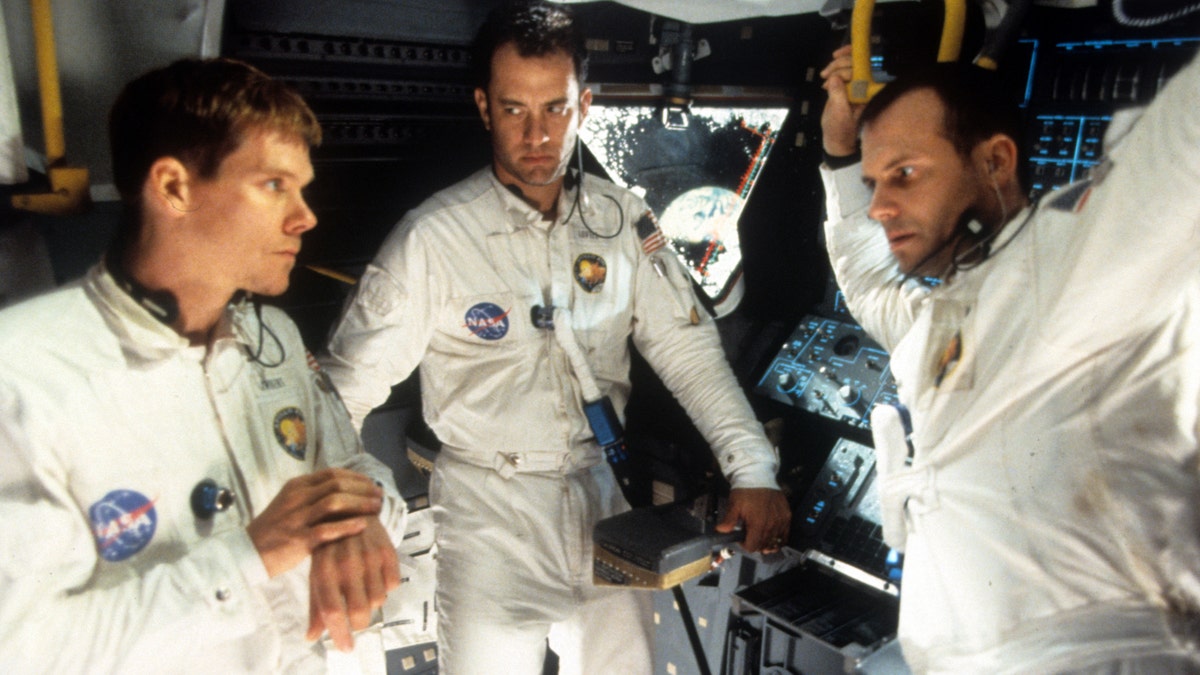
Kevin Bacon, Tom Hanks, and Bill Paxton talking in ship in a scene from the film 'Apollo 13', 1995. (Photo by Universal/Getty Images)
A stunning NASA video recently recreated Apollo 13’s trip around the moon using images captured by the space agency’s Lunar Reconnaissance Orbiter.
To commemorate the 50th anniversary, a panoramic high-definition image of the interior of the Apollo 13 interior, with Haise napping, has been produced by photography specialist Andy Saunders. "Step on-board Apollo 13 in this fascinating new image revealing what life was really like on the stricken mission,” said Saunders, a property developer in the U.K., in a statement emailed to Fox News.
CLICK HERE TO GET THE FOX NEWS APP
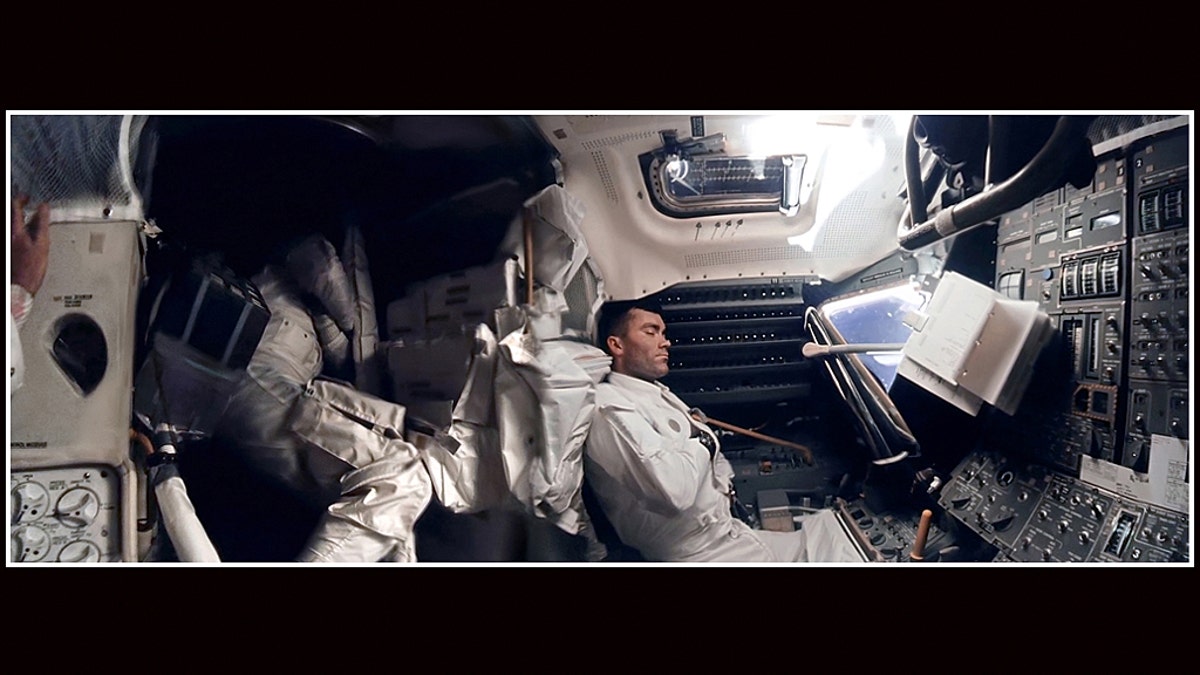
The panoramic hi-def image of interior of the Apollo 13 Lunar Module. Astronaut Fred Haise (right) is napping, while Jack Swigert can be seen curled up in the storage area. Commander Jim Lovell's hand can be seen in the left of the picture. (NASA/Andy Saunders)
California-based film-maker Steven Barber is also working on a project to build a monument to the Apollo 13 crewmembers at Johnson Space Center, in Houston. “The Apollo 13 monument is currently in the beginning stages of molding and being built and has been funded,” he told Fox News, via email. “We are looking at December 1 to unveil at the Johnson Space Center for millions and millions to enjoy for the next several decades.”
Fox News’ Chris Ciaccia and Christopher Carbone contributed to this article. Follow James Rogers on Twitter @jamesjrogers

